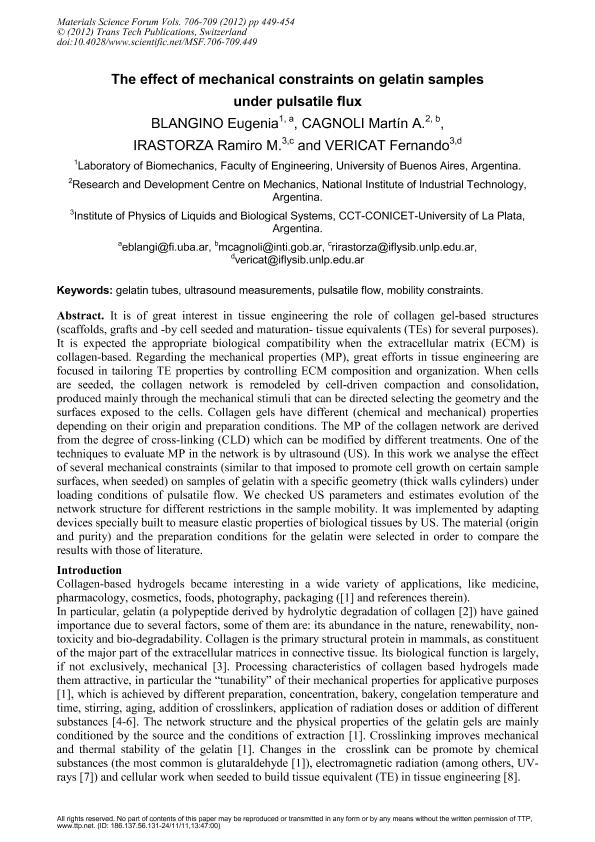Mostrar el registro sencillo del ítem
dc.contributor.author
Blangino, Eugenia
dc.contributor.author
Cagnoli, Martín A.
dc.contributor.author
Irastorza, Ramiro Miguel

dc.contributor.author
Vericat, Fernando

dc.date.available
2020-01-07T18:25:00Z
dc.date.issued
2012-06
dc.identifier.citation
Blangino, Eugenia; Cagnoli, Martín A.; Irastorza, Ramiro Miguel; Vericat, Fernando; The effect of mechanical constraints on gelatin samples under pulsatile flux; Trans Tech Publications; Materials Science Forum; 706-709; 6-2012; 449-454
dc.identifier.issn
0255-5476
dc.identifier.uri
http://hdl.handle.net/11336/93842
dc.description.abstract
It is of great interest in tissue engineering the role of collagen gel-based structures (scaffolds, grafts and -by cell seeded and maturation- tissue equivalents (TEs) for several purposes). It is expected the appropriate biological compatibility when the extracellular matrix (ECM) is collagen-based. Regarding the mechanical properties (MP), great efforts in tissue engineering are focused in tailoring TE properties by controlling ECM composition and organization. When cells are seeded, the collagen network is remodeled by cell-driven compaction and consolidation, produced mainly through the mechanical stimuli that can be directed selecting the geometry and the surfaces exposed to the cells. Collagen gels have different (chemical and mechanical) properties depending on their origin and preparation conditions. The MP of the collagen network are derived from the degree of cross-linking (CLD) which can be modified by different treatments. One of the techniques to evaluate MP in the network is by ultrasound (US). In this work we analyse the effect of several mechanical constraints (similar to that imposed to promote cell growth on certain sample surfaces, when seeded) on samples of gelatin with a specific geometry (thick walls cylinders) under loading conditions of pulsatile flow. We checked US parameters and estimates evolution of the network structure for different restrictions in the sample mobility. It was implemented by adapting devices specially built to measure elastic properties of biological tissues by US. The material (origin and purity) and the preparation conditions for the gelatin were selected in order to compare the results with those of literature.
dc.format
application/pdf
dc.language.iso
eng
dc.publisher
Trans Tech Publications

dc.rights
info:eu-repo/semantics/openAccess
dc.rights.uri
https://creativecommons.org/licenses/by-nc-sa/2.5/ar/
dc.subject
GELATIN TUBES
dc.subject
MOBILITY CONSTRAINTS
dc.subject
PULSATILE FLOW
dc.subject
ULTRASOUND MEASUREMENTS
dc.subject.classification
Otras Ciencias Físicas

dc.subject.classification
Ciencias Físicas

dc.subject.classification
CIENCIAS NATURALES Y EXACTAS

dc.title
The effect of mechanical constraints on gelatin samples under pulsatile flux
dc.type
info:eu-repo/semantics/article
dc.type
info:ar-repo/semantics/artículo
dc.type
info:eu-repo/semantics/publishedVersion
dc.date.updated
2019-05-03T17:35:44Z
dc.journal.volume
706-709
dc.journal.pagination
449-454
dc.journal.pais
Suiza

dc.journal.ciudad
Zurich
dc.description.fil
Fil: BLANGINO, Eugenia.
dc.description.fil
Fil: CAGNOLI, Martín A..
dc.description.fil
Fil: IRASTORZA, Ramiro M..
dc.description.fil
Fil: Vericat, Fernando.
dc.journal.title
Materials Science Forum

dc.relation.alternativeid
info:eu-repo/semantics/altIdentifier/url/https://www.scientific.net/MSF.706-709.449
dc.relation.alternativeid
info:eu-repo/semantics/altIdentifier/doi/http://dx.doi.org/10.4028/www.scientific.net/MSF.706-709.449
Archivos asociados
